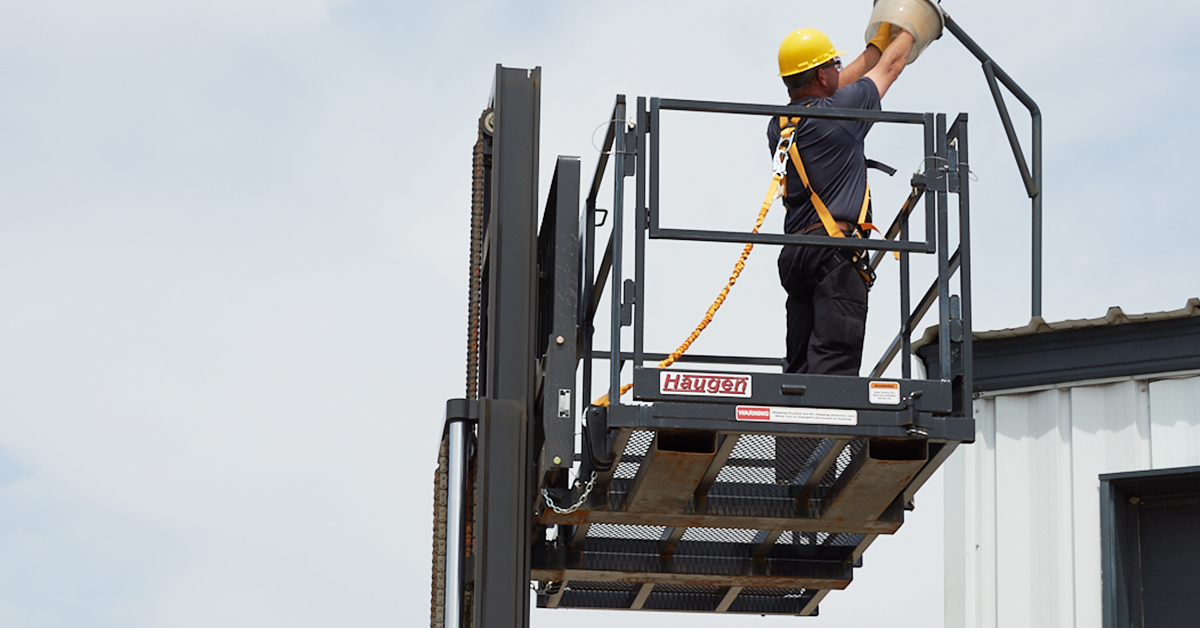Safely using forklift cages
Date Posted: 12/30/2024

Employers are using forklift attachments more than ever and one of the most common attachments are cages used to raise workers to reach elevated areas. However, many employers do not know the hazards of using a forklift cage, how to safely use the cage, and what to train employees on.
First, if you have a homemade cage, get it certified by either the manufacturer or an engineer. For an employee to move around the cage safely, it must be built correctly. The sides of the cage and the door must have a mid-rail and top rail. The cage door has to be retractable to close behind the employee, or you can put on removable railings. The removable railings must always be in place when an employee is in the cage.
The need for fall protection
Employees must wear a fall protection system once they are four feet from the ground. If the employee leaves the cage to go into a racking system or other working surface, make sure your employees wear their fall protection. Employees must have an anchor point either on the forklift or the cage, wear a D ring, and have two lanyards. One lanyard must stay hooked to the forklift and the other must be hooked to the racking system.
If the employee falls, neither the forklift, the cage, or the racking system should go tumbling down with the employee. The employee must fall in a sitting position in order to be rescued. Have an engineer determine whether the forklift can sustain the force of the employee falling along with the cage’s weight.
Other safety precautions
Always park the forklift when employees are trying to reach higher levels. If there are two employees, make sure the operator does not have the forklift in drive when the employee in the cage is trying to reach for materials in a racking system. If the operator is driving on uneven pavement and an employee is in the elevated cage, it's likely that an employee in the cage can catapult from the area where they are at. If you are going to be traveling with an employee in the cage, make sure you are traveling with the forks on the ground.
Employees should not climb onto racks not built for human use. Some racks are not rated for it because they don’t have a floor on each rack level where employees can freely walk on the racks. The racks also don’t have mid-rails and top rails to keep employees from falling off. If your racking system is rated for human occupancy, then employees can leave the cage with their fall protection to get materials from a rack; otherwise, they can’t be on the racking system.
Following the recommendations above helps ensure employees won’t have a serious injury or fatality. As the racking systems and forklifts get taller, employees could fall from greater heights, and the resulting injuries would be more severe. Make sure you provide forklift training, fall protection training, and a rescue plan to your employees so they understand the hazards and obstacles they face when using a forklift cage.
How Safety Management Suite Can Help
We know you want to keep your employees safe, and training plays a large role in that effort. The Training area of the J. J. Keller® SAFETY MANAGEMENT SUITE provides an array of resources, including online and classroom training, quizzes, handouts, five-minute talks, videos, and PowerPoint presentations.
E-mail Newsletter
Sign up to receive the weekly EHS Insider email newsletter for safety articles, news headlines, regulatory alerts, industry events, webcasts, and more.